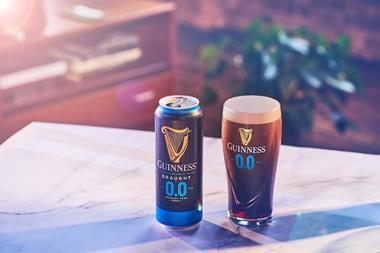Everyone loves a scapegoat. The government and the British public are so busy blaming someone else for rising obesity they seem to have forgotten their own part in it all. Successive governments until recently have all but ignored sport as part of the school curriculum. And as for UK consumers - well, they really did eat all the pies.
Rising obesity among children, and adults, is not a simple issue and covers a whole spectrum of societal and lifestyle issues. However, all of the attention has focused around the fault of food and drink manufacturers.
For years organisations such as the Consumers' Association (now Which?) and the Food Commission had blamed the poor diets of our children on the "cynical" advertising of junk food. However, until 2003 much of the criticism was built on assumption, rumour and ill will.
Then came the report that changed everything - a research review into the effects of food advertising to children (we go into this in more detail on p40). It concluded there was sufficient evidence to suggest that food promotion does affect children's preferences, purchase behaviour and consumption. On the back of this, in 2004 the FSA agreed an Action Plan on Food Promotion and Children's Diets. This included industry guidelines for reducing amounts of fat, sugar and salt in products aimed at children and agreeing new labelling guidelines to ensure consumers could more easily identify healthier options.
So far, so reasonable.
The FSA then commissioned work to identify options for nutrient profiles that could be used to define "healthier food choices" and "foods high in fat, salt and sugar" in relation to food promotion aimed at children.
All the work was overseen by an expert group of nutritionists, industry and consumer representatives and policy makers. It agreed the project should focus on the development and testing of definitions for high fat, salt or sugar foods and healthier options for children aged 11-16. However, they agreed it should also apply to children aged five to 10 and also to adults.
In the initial stages the group looked at other nutrient profiles from around the world, particularly those in North America. Significantly, it noted the most common choice of base for nutrient profiling was per serving, that few schemes attempted scoring systems and that many took vitamins and minerals into account when profiling food.
The FSA's final model ignores all of this. Gaynor Bussell, the Food and Drink Federation's nutrition manager, says the FSA's model could confuse consumers and does little to teach them to take a more holistic approach to diet. The model itself will not be visible to consumers, but Bussell adds: "Who knows where its use will end? If it did become visible to consumers, it could encourage neuroticism around food."
Bussell is right to be concerned. Despite FSA claims that its model is only intended to judge whether or not food should be allowed to advertise to children, its own documents state the contrary.
Nutrient Profiles: Options for Definitions for use in Relation to Food Promotions and Children's Diets, published in October 2004, says: "The model that has been developed has potential for use to underpin a range of interventions, including some involving consumer information and public health messages."
So how did we arrive at a situation where, as we illustrate opposite and overleaf, the FSA has banned advertising of products to children that are healthy and nutritious?
The expert group initially came up with and tested more than a dozen different models using a variety of methods to judge food. In these early stages the models didn't only penalise food for including too much sugar, fat or salt but rewarded them for fruit, vegetables, long chain n-3 polyunsaturated fatty acids and, crucially, iron and calcium.
The FSA's experts also agreed that where calcium, iron and n-3 fatty acids were taken into account, this would only include levels prior to discretionary fortification.
Much discussion focused on whether or not foods should be judged per serving, per 100g or per 100kj of energy. The pros and cons of each base were considered before the 100g measure was finally deemed to work the best.
Despite reflecting the way people actually eat, per serving was thrown out because the group felt serving sizes were difficult to pin down and also didn't take into account how frequently certain foods were eaten.
The group also dismissed per 100kj of energy as a measurement. The pros for this base included the fact that there is a strong correlation between nutrient per serving and nutrient per 100kj because the amount of food that people eat is generally governed by their energy needs.
However, the group also felt some foods, such as fruit and vegetables with a high water content and a very small amount of energy (either per serving or per 100g) would be penalised by this measurement. If this small amount of energy is from a small amount of fat or sugar, then the food would appear to have a large amount of this nutrient when measured per 100kj.
The group also considered combining bases, but later dismissed this option.
Next, the experts had to decide what type of model to use: one based on nutrient thresholds, one based on a simple scoring system or one based on a complex scoring system. Using thresholds would make the model easy to understand, particularly for consumers. However, it could also work against essentially healthy foods. For instance, if it cited 'must contain less than 45kj fat per 100kj' in line with the Coronary Prevention Group Nutrition Banding Scheme definition of high fat foods, it would automatically label grilled fish, tofu and nuts as unhealthy.
Complex scoring, the group decided, while ironing out most anomalies, would overly complicate the classification of foods and make it more difficult for food manufacturers to reformulate products to fit healthy criteria.
Though more complex than threshold models, simple scoring would still work in a similar way with a threshold set for each nutrient, according to the group. This creates a series of bands, and depending on which band the food lies in for each nutrient, a certain number of points are scored (see last week's issue for a full explanation of how the scores are applied). The group also pointed out that scoring could be used for various purposes, with a certain score set to restrict foods from advertising to children and another dictating how, and, if it may use on-pack health claims.
Finally, the group had to decide how it would award the scores. It agreed that threshold levels and points scored should bear a "transparent relationship to agreed health recommendations but the numbers chosen in this way should be checked against those used by respected sources".
While there's no disputing that a lot of time, energy and expertise went into developing the FSA's model, it's also apparent many of the final decisions governing how it was developed owed more to experience and pragmatic gut feeling than scientific precedent. Months of testing and discussion finally gave way to three models, which were further put through the mill, with changes made incrementally so that the effect of every change could be analysed.
Between November 2004 and March 2005 the FSA put its chosen model out to consultation. It received more than 80 responses from interested parties - including food manufacturers, public health bodies, local authorities and consumer organisations.
Further testing and alterations - most noticeably the inclusion of nuts in the fruit and vegetable scores - brought the FSA more or less to the model that Ofcom is using to enforce its ban on advertising junk food to children.
The final model rejected taking iron, calcium and n-3 fatty acids into account - replacing them with a 'catch-all' protein score to prevent fortified foods flying under the Ofcom radar.
Little use to cheese, which isn't allowed to use its protein points because it doesn't score for fruit, vegetables or nuts.
So unless we - The Grocer and you in the industry - can convince Ofcom otherwise, this model will continue to punish innocent victims in search of a scapegoat. nwhat would an advertising ban achieve?
The bitter irony of this ban is that, while it damages the food and drink industry and harms the fortunes of products that are healthy and nutritious when used in normal portions, evidence suggests that it is likely to have little effect on obesity levels in children.
One of the most cited studies is the Bolton Report, which found that children's exposure to food adverts had only a 2% effect on snacking frequency and suggested parents were more likely to influence children than TV advertising.
While Strathclyde University research concludes that advertising to kids has an adverse effect on their knowledge of food, preferences and behaviour, it admits: "Incontrovertible proof simply isn't attainable."
To establish a definite link between food promotion, diet or obesity would require research in "real world settings", says the report. However, two "real life" studies - in Quebec and Sweden, were largely ignored.
The Quebec ban on food advertising to children began in 1980, but there is little evidence that childhood obesity is lower than other Canadian provinces.
Sweden banned all TV and radio ads aimed at children under 12 in 1991 - again there is little to suggest this has reduced levels of childhood obesity.
According to a survey of nearly 2,000 adults by The Grocer/Harris Interactive, just half of adults believe that a ban on junk food advertising will make a difference to children's diets and some 90% of adults say they make the majority of main meal purchase decisions.
Just 11% of respondents feel a TV advertising ban should include products that are healthy when eaten in moderation, such as dairy products and dried fruit.
84% of those questioned believe sport and exercise is the most important tool in tackling obesity, with promotion of healthy food and a balanced diet also scoring highly at 69%.
Banning junk food ads was considered the least effective way of combating expanding waistlines with only 33% believing this is the way forward.Timeline
22 September 2003: Strathclyde University publishes Review of Research on the Effects of Food Promotion to Children, known as the Hastings Report, which claims there is a link between food promotion activity and children's eating behaviour
6 July 2004: The FSA agrees action on promotion to children based on the report. Plans include signposting of healthier options on shelves, nutritional guidelines for children's food ranges, the promotion of healthier vending machines in schools, promotions by the food industry to encourage children to eat healthier foods, action to address the imbalance of TV advertising of food to children, and instructions from Ofcom to develop a Nutrient Profiling Model to instruct how it might ban HFSS foods from advertising
November 2004: FSA begins first phase of NPM development involving testing of different models
February 2005: Second phase of development based on issues in consultation and peer review
7 September 2005: FSA publishes report on development of its Nutrient Profiling Model
6 December 2005: FSA delivers NPM to Ofcom
30 June 2006: FSA chair Deirdre Hutton writes to Ofcom in response to its consultation on options for tighter controls on TV advertising of food to children
17 November 2006 : Ofcom publishes final details of restrictions on TV advertising of food and drink products high in fat, salt and sugar to children
Feb 2007: Final Ofcom decision on timing of ban
March 2007: Changes to scheduling rules affecting ads seen by under-16s come into effect
Autumn 2008: Ofcom expected to review effectiveness and scope of new restrictions
Rising obesity among children, and adults, is not a simple issue and covers a whole spectrum of societal and lifestyle issues. However, all of the attention has focused around the fault of food and drink manufacturers.
For years organisations such as the Consumers' Association (now Which?) and the Food Commission had blamed the poor diets of our children on the "cynical" advertising of junk food. However, until 2003 much of the criticism was built on assumption, rumour and ill will.
Then came the report that changed everything - a research review into the effects of food advertising to children (we go into this in more detail on p40). It concluded there was sufficient evidence to suggest that food promotion does affect children's preferences, purchase behaviour and consumption. On the back of this, in 2004 the FSA agreed an Action Plan on Food Promotion and Children's Diets. This included industry guidelines for reducing amounts of fat, sugar and salt in products aimed at children and agreeing new labelling guidelines to ensure consumers could more easily identify healthier options.
So far, so reasonable.
The FSA then commissioned work to identify options for nutrient profiles that could be used to define "healthier food choices" and "foods high in fat, salt and sugar" in relation to food promotion aimed at children.
All the work was overseen by an expert group of nutritionists, industry and consumer representatives and policy makers. It agreed the project should focus on the development and testing of definitions for high fat, salt or sugar foods and healthier options for children aged 11-16. However, they agreed it should also apply to children aged five to 10 and also to adults.
In the initial stages the group looked at other nutrient profiles from around the world, particularly those in North America. Significantly, it noted the most common choice of base for nutrient profiling was per serving, that few schemes attempted scoring systems and that many took vitamins and minerals into account when profiling food.
The FSA's final model ignores all of this. Gaynor Bussell, the Food and Drink Federation's nutrition manager, says the FSA's model could confuse consumers and does little to teach them to take a more holistic approach to diet. The model itself will not be visible to consumers, but Bussell adds: "Who knows where its use will end? If it did become visible to consumers, it could encourage neuroticism around food."
Bussell is right to be concerned. Despite FSA claims that its model is only intended to judge whether or not food should be allowed to advertise to children, its own documents state the contrary.
Nutrient Profiles: Options for Definitions for use in Relation to Food Promotions and Children's Diets, published in October 2004, says: "The model that has been developed has potential for use to underpin a range of interventions, including some involving consumer information and public health messages."
So how did we arrive at a situation where, as we illustrate opposite and overleaf, the FSA has banned advertising of products to children that are healthy and nutritious?
The expert group initially came up with and tested more than a dozen different models using a variety of methods to judge food. In these early stages the models didn't only penalise food for including too much sugar, fat or salt but rewarded them for fruit, vegetables, long chain n-3 polyunsaturated fatty acids and, crucially, iron and calcium.
The FSA's experts also agreed that where calcium, iron and n-3 fatty acids were taken into account, this would only include levels prior to discretionary fortification.
Much discussion focused on whether or not foods should be judged per serving, per 100g or per 100kj of energy. The pros and cons of each base were considered before the 100g measure was finally deemed to work the best.
Despite reflecting the way people actually eat, per serving was thrown out because the group felt serving sizes were difficult to pin down and also didn't take into account how frequently certain foods were eaten.
The group also dismissed per 100kj of energy as a measurement. The pros for this base included the fact that there is a strong correlation between nutrient per serving and nutrient per 100kj because the amount of food that people eat is generally governed by their energy needs.
However, the group also felt some foods, such as fruit and vegetables with a high water content and a very small amount of energy (either per serving or per 100g) would be penalised by this measurement. If this small amount of energy is from a small amount of fat or sugar, then the food would appear to have a large amount of this nutrient when measured per 100kj.
The group also considered combining bases, but later dismissed this option.
Next, the experts had to decide what type of model to use: one based on nutrient thresholds, one based on a simple scoring system or one based on a complex scoring system. Using thresholds would make the model easy to understand, particularly for consumers. However, it could also work against essentially healthy foods. For instance, if it cited 'must contain less than 45kj fat per 100kj' in line with the Coronary Prevention Group Nutrition Banding Scheme definition of high fat foods, it would automatically label grilled fish, tofu and nuts as unhealthy.
Complex scoring, the group decided, while ironing out most anomalies, would overly complicate the classification of foods and make it more difficult for food manufacturers to reformulate products to fit healthy criteria.
Though more complex than threshold models, simple scoring would still work in a similar way with a threshold set for each nutrient, according to the group. This creates a series of bands, and depending on which band the food lies in for each nutrient, a certain number of points are scored (see last week's issue for a full explanation of how the scores are applied). The group also pointed out that scoring could be used for various purposes, with a certain score set to restrict foods from advertising to children and another dictating how, and, if it may use on-pack health claims.
Finally, the group had to decide how it would award the scores. It agreed that threshold levels and points scored should bear a "transparent relationship to agreed health recommendations but the numbers chosen in this way should be checked against those used by respected sources".
While there's no disputing that a lot of time, energy and expertise went into developing the FSA's model, it's also apparent many of the final decisions governing how it was developed owed more to experience and pragmatic gut feeling than scientific precedent. Months of testing and discussion finally gave way to three models, which were further put through the mill, with changes made incrementally so that the effect of every change could be analysed.
Between November 2004 and March 2005 the FSA put its chosen model out to consultation. It received more than 80 responses from interested parties - including food manufacturers, public health bodies, local authorities and consumer organisations.
Further testing and alterations - most noticeably the inclusion of nuts in the fruit and vegetable scores - brought the FSA more or less to the model that Ofcom is using to enforce its ban on advertising junk food to children.
The final model rejected taking iron, calcium and n-3 fatty acids into account - replacing them with a 'catch-all' protein score to prevent fortified foods flying under the Ofcom radar.
Little use to cheese, which isn't allowed to use its protein points because it doesn't score for fruit, vegetables or nuts.
So unless we - The Grocer and you in the industry - can convince Ofcom otherwise, this model will continue to punish innocent victims in search of a scapegoat. nwhat would an advertising ban achieve?
The bitter irony of this ban is that, while it damages the food and drink industry and harms the fortunes of products that are healthy and nutritious when used in normal portions, evidence suggests that it is likely to have little effect on obesity levels in children.
One of the most cited studies is the Bolton Report, which found that children's exposure to food adverts had only a 2% effect on snacking frequency and suggested parents were more likely to influence children than TV advertising.
While Strathclyde University research concludes that advertising to kids has an adverse effect on their knowledge of food, preferences and behaviour, it admits: "Incontrovertible proof simply isn't attainable."
To establish a definite link between food promotion, diet or obesity would require research in "real world settings", says the report. However, two "real life" studies - in Quebec and Sweden, were largely ignored.
The Quebec ban on food advertising to children began in 1980, but there is little evidence that childhood obesity is lower than other Canadian provinces.
Sweden banned all TV and radio ads aimed at children under 12 in 1991 - again there is little to suggest this has reduced levels of childhood obesity.
According to a survey of nearly 2,000 adults by The Grocer/Harris Interactive, just half of adults believe that a ban on junk food advertising will make a difference to children's diets and some 90% of adults say they make the majority of main meal purchase decisions.
Just 11% of respondents feel a TV advertising ban should include products that are healthy when eaten in moderation, such as dairy products and dried fruit.
84% of those questioned believe sport and exercise is the most important tool in tackling obesity, with promotion of healthy food and a balanced diet also scoring highly at 69%.
Banning junk food ads was considered the least effective way of combating expanding waistlines with only 33% believing this is the way forward.Timeline
22 September 2003: Strathclyde University publishes Review of Research on the Effects of Food Promotion to Children, known as the Hastings Report, which claims there is a link between food promotion activity and children's eating behaviour
6 July 2004: The FSA agrees action on promotion to children based on the report. Plans include signposting of healthier options on shelves, nutritional guidelines for children's food ranges, the promotion of healthier vending machines in schools, promotions by the food industry to encourage children to eat healthier foods, action to address the imbalance of TV advertising of food to children, and instructions from Ofcom to develop a Nutrient Profiling Model to instruct how it might ban HFSS foods from advertising
November 2004: FSA begins first phase of NPM development involving testing of different models
February 2005: Second phase of development based on issues in consultation and peer review
7 September 2005: FSA publishes report on development of its Nutrient Profiling Model
6 December 2005: FSA delivers NPM to Ofcom
30 June 2006: FSA chair Deirdre Hutton writes to Ofcom in response to its consultation on options for tighter controls on TV advertising of food to children
17 November 2006 : Ofcom publishes final details of restrictions on TV advertising of food and drink products high in fat, salt and sugar to children
Feb 2007: Final Ofcom decision on timing of ban
March 2007: Changes to scheduling rules affecting ads seen by under-16s come into effect
Autumn 2008: Ofcom expected to review effectiveness and scope of new restrictions

















No comments yet